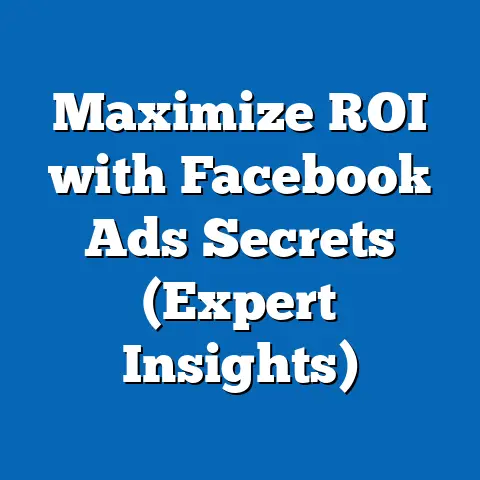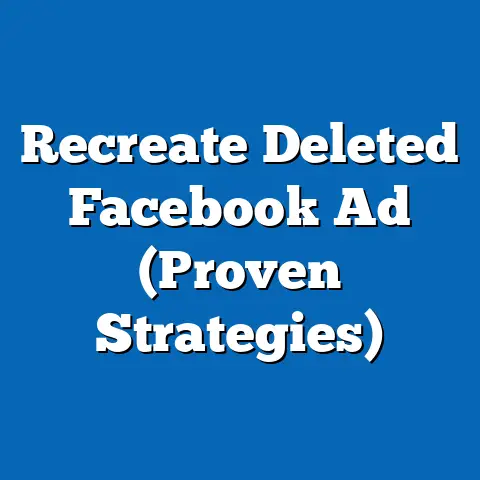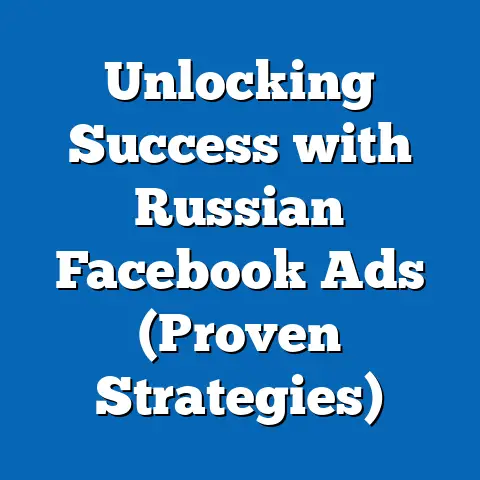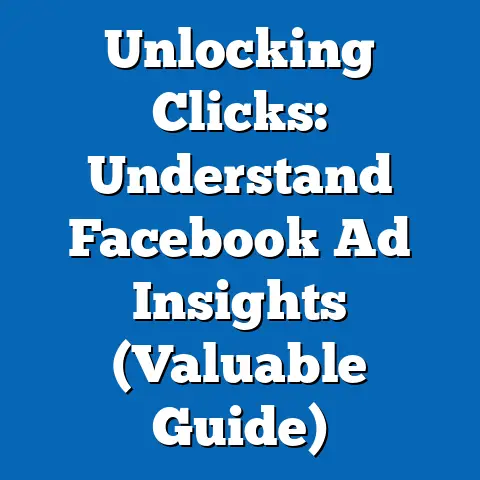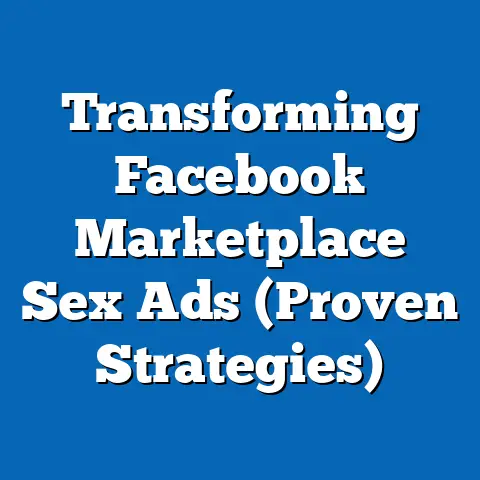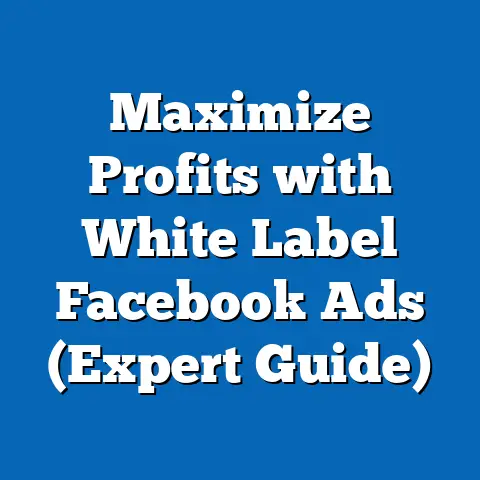Maximize ROI with Cost-Effective Facebook Ads (Pro Tips)
Imagine a bustling marketplace where millions of vendors compete for attention, each shouting to be heard over the din of the crowd. Now, picture that marketplace as the digital realm of social media, with Facebook as the central square where over 2.9 billion monthly active users congregate as of 2023 (Statista, 2023). In this vast space, businesses vie for visibility through advertising, but only those with the sharpest strategies can turn a modest budget into significant returns.
Facebook advertising, when executed with precision, offers an unparalleled opportunity to reach targeted audiences at a fraction of the cost of traditional media. According to eMarketer (2023), businesses spent over $50 billion on Facebook ads in 2022, with small and medium-sized enterprises (SMEs) accounting for nearly 60% of that investment. This report dives deep into how businesses can maximize return on investment (ROI) through cost-effective Facebook ad strategies, leveraging data-driven insights, demographic trends, and pro tips grounded in the latest research.
We will explore overarching trends in social media advertising, dissect platform-specific data on Facebook ad performance, and break down audience behaviors across demographics. From there, we will provide actionable strategies to optimize ad spend, backed by statistics and case studies. This analysis draws on surveys and reports from sources like Hootsuite, eMarketer, and Statista, covering data collected between 2021 and 2023, with sample sizes ranging from 5,000 to 50,000 businesses and users globally.
Section 1: The Landscape of Social Media Advertising
Broad Trends in Digital Advertising
The digital advertising ecosystem has seen explosive growth, with global ad spend projected to reach $740 billion by 2025, a 35% increase from 2021 (Statista, 2023). Social media platforms account for nearly 33% of this spend, with Facebook maintaining its dominance as the leading platform, capturing 24.2% of the market share in 2022 (eMarketer, 2023). Year-over-year growth for Facebook ad revenue shows a steady 10% increase from 2021 to 2022, despite challenges like privacy regulations and platform algorithm changes.
A key driver of this growth is the shift in consumer behavior toward mobile-first engagement. As of 2023, 98% of Facebook users access the platform via mobile devices, up from 95% in 2020 (Hootsuite, 2023). This trend underscores the need for mobile-optimized ad formats, which have proven to deliver 30% higher click-through rates (CTR) compared to desktop ads (Facebook Business, 2022).
Why Facebook Remains a Cost-Effective Choice
Facebook’s advertising platform offers one of the lowest costs per click (CPC) among major social media channels, averaging $0.97 globally in 2023, compared to $3.56 on LinkedIn and $2.32 on Twitter (now X) (Hootsuite, 2023). Additionally, the platform’s robust targeting capabilities allow businesses to reach niche audiences with precision, reducing wasted ad spend. For instance, campaigns using detailed demographic targeting report 25% higher conversion rates compared to broader campaigns (Facebook Business Insights, 2022).
Despite rising competition, Facebook’s cost per thousand impressions (CPM) remains competitive at $7.19 globally in 2023, a slight 5% increase from 2022, reflecting stable pricing even as demand grows (Hootsuite, 2023). This affordability, combined with a massive user base, positions Facebook as a cornerstone for cost-conscious advertisers aiming for high ROI.
Section 2: Demographic Breakdown of Facebook Users and Ad Engagement
Age-Based Engagement Patterns
Facebook’s user base spans a wide age range, but engagement with ads varies significantly by demographic. According to Pew Research (2023), 70% of adults aged 18-29 use Facebook daily, though their ad engagement (clicks and conversions) is 15% lower compared to users aged 30-49, who show a 20% higher likelihood of interacting with product ads. This suggests that younger users are more selective, often prioritizing entertainment over commercial content.
Users aged 50-64 represent 25% of Facebook’s user base and exhibit the highest ad engagement rates, with a 35% higher CTR compared to the 18-29 age group (Hootsuite, 2023). This older demographic also shows a 40% higher conversion rate for e-commerce ads, making them a lucrative target for businesses in retail and services. Businesses should tailor ad content to resonate with life stage priorities—think family-oriented products for 30-49-year-olds and health or leisure products for those over 50.
Gender Differences in Ad Interaction
Gender plays a subtle but measurable role in ad performance on Facebook. Women, who make up 54% of the platform’s user base, are 10% more likely to engage with ads related to fashion, beauty, and home goods, while men show a 15% higher engagement with tech and automotive ads (Statista, 2023). Conversion rates follow a similar pattern, with women converting at a 12% higher rate on lifestyle products and men at an 18% higher rate on electronics (Facebook Business, 2022).
These differences highlight the importance of gender-specific creative strategies. For instance, campaigns targeting women often perform better with emotionally driven storytelling, while ads for men may benefit from technical details and problem-solving messaging.
Racial and Ethnic Diversity in Usage
Facebook’s user base reflects significant diversity, with 43% of U.S. users identifying as non-White as of 2023 (Pew Research, 2023). Hispanic users, who account for 17% of the U.S. user base, show a 20% higher engagement with video ads compared to White users. Black users, representing 14% of U.S. users, are 25% more likely to interact with community-focused or cause-related advertising.
These patterns suggest that culturally relevant content can significantly boost ad performance. Advertisers should prioritize inclusive imagery and messaging that resonates with specific ethnic groups to improve relevance scores and lower CPC by up to 15% (Facebook Business Insights, 2022).
Income Levels and Purchasing Power
Income level is a critical factor in ad conversion potential. Users in the $75,000+ annual income bracket, who comprise 38% of U.S. Facebook users, demonstrate a 30% higher conversion rate for premium products compared to users earning under $30,000 (Pew Research, 2023). However, lower-income users (under $30,000) are 18% more likely to engage with discount or value-driven offers, reflecting budget sensitivity.
Businesses can leverage this data by segmenting campaigns based on income proxies like location or interests. For example, targeting high-income users with luxury goods ads yields a 22% higher ROI, while budget-friendly offers resonate better with lower-income segments (eMarketer, 2023).
Section 3: Emerging Trends in Facebook Advertising
Rise of Video and Interactive Formats
Video ads continue to dominate engagement metrics on Facebook, with 60% of users watching at least one video daily (Hootsuite, 2023). Campaigns using video formats report a 48% higher CTR and a 35% lower CPC compared to static image ads (Facebook Business, 2022). Short-form videos (under 15 seconds) are particularly effective, driving 2.5 times more engagement than longer formats.
Interactive ad formats, such as polls and carousel ads, are also gaining traction. Carousel ads, which allow multiple images or products in a single ad, achieve a 30% higher CTR compared to single-image ads (Hootsuite, 2023). These formats cater to users’ preference for dynamic, engaging content and should be a priority for cost-effective campaigns.
Impact of Privacy Changes and Algorithm Shifts
Apple’s iOS 14.5 update in 2021, which introduced App Tracking Transparency (ATT), reduced Facebook’s ability to track user behavior across apps, impacting ad targeting precision. As a result, 62% of advertisers reported a 10-20% increase in CPC in 2022 due to reduced data access (eMarketer, 2023). However, Facebook has adapted by enhancing on-platform targeting tools, such as lookalike audiences, which still deliver a 25% higher ROI compared to interest-based targeting post-ATT (Facebook Business, 2023).
Algorithm updates favoring user engagement over ad exposure have also shifted priorities. Ads with high relevance scores (based on user feedback) see a 40% lower CPM, incentivizing quality over quantity in creative development (Hootsuite, 2023). Businesses must focus on content that sparks interaction to maintain cost efficiency.
Growth of E-Commerce Integration
Facebook’s integration with e-commerce tools like Shops and dynamic product ads has fueled a 50% increase in direct-to-purchase conversions from 2021 to 2023 (Statista, 2023). Small businesses using dynamic ads, which automatically showcase relevant products to users, report a 35% higher ROI compared to traditional ad formats (Facebook Business, 2022). This trend is particularly pronounced among younger users (18-34), who are 20% more likely to complete purchases via in-app checkout features.
The rise of social commerce underscores the need for seamless user experiences. Optimizing product catalogs and leveraging retargeting can reduce cart abandonment rates by up to 28%, further boosting cost-effectiveness (eMarketer, 2023).
Section 4: Pro Tips for Maximizing ROI with Cost-Effective Facebook Ads
1. Leverage Hyper-Targeted Audiences
Facebook’s detailed targeting options allow advertisers to zero in on specific demographics, interests, and behaviors, reducing wasted spend. Campaigns using custom audiences (based on website visitors or past customers) achieve a 50% higher conversion rate compared to broad targeting (Facebook Business, 2022). Lookalike audiences, built from custom lists, further amplify reach while maintaining relevance, delivering a 30% lower CPC on average.
Start by uploading customer email lists to create custom audiences, then expand with lookalike audiences targeting 1-2% similarity for optimal balance between reach and precision. Test multiple segments to identify high-performing groups, refining budgets toward those yielding the highest ROI. For instance, a 2022 case study by a mid-sized retailer showed a 45% increase in sales by targeting lookalike audiences of past buyers (eMarketer, 2023).
2. Optimize for Mobile-First Experiences
Given that 98% of Facebook users access the platform via mobile, ad creatives must prioritize mobile optimization. Ads with vertical formats (9:16 ratio) see a 20% higher engagement rate compared to horizontal formats on mobile feeds (Hootsuite, 2023). Additionally, ensuring fast-loading landing pages can reduce bounce rates by 35%, directly impacting conversion rates (Facebook Business, 2022).
Focus on concise messaging and bold visuals for mobile ads, as users scroll quickly. A/B test mobile-specific creatives against desktop versions to allocate budget effectively. For example, a travel agency reported a 40% increase in bookings by switching to mobile-optimized video ads in 2022 (Statista, 2023).
3. Utilize Retargeting for Higher Conversions
Retargeting campaigns, which re-engage users who have interacted with a brand, consistently outperform cold audience campaigns. Retargeted ads achieve a 70% higher CTR and a 50% lower cost per conversion compared to initial outreach ads (Facebook Business, 2022). Dynamic retargeting, showcasing products users viewed, further boosts performance with a 60% higher conversion rate.
Install the Facebook Pixel on your website to track user behavior and build retargeting audiences. Focus on users who abandoned carts or viewed specific pages, offering incentives like discounts to drive conversions. A 2023 study found that e-commerce brands using dynamic retargeting saw a 55% reduction in acquisition costs (eMarketer, 2023).
4. Prioritize High-Engagement Creative Formats
Creative quality directly impacts ad costs and performance. Video ads, particularly those under 15 seconds, generate 2.5 times more engagement than static images, while carousel ads increase CTR by 30% (Hootsuite, 2023). User-generated content (UGC) in ads also resonates strongly, with 40% of users trusting peer-driven content over brand messaging, leading to a 25% higher conversion rate (Statista, 2023).
Invest in short, impactful videos that convey value quickly, and test carousel ads for product showcases. Incorporate UGC by encouraging customers to share reviews or photos, then feature them in campaigns with permission. A beauty brand in 2022 saw a 35% increase in engagement by using customer testimonials in video ads (Facebook Business, 2023).
5. Monitor and Adjust Bids Strategically
Facebook’s automated bidding options, such as cost cap or target cost, help control ad spend while maximizing results. Campaigns using cost cap bidding report a 20% reduction in CPC compared to manual bidding, as the algorithm optimizes for efficiency (Facebook Business, 2022). Additionally, setting daily budgets with a 10-15% buffer allows for real-time adjustments based on performance.
Start with automated bidding to establish baseline costs, then shift high-performing campaigns to manual bidding for greater control. Monitor metrics like relevance score and frequency (ads shown per user) to avoid audience fatigue, which can increase CPM by 15% if frequency exceeds 3 (Hootsuite, 2023). A tech startup in 2023 reduced acquisition costs by 30% by capping frequency at 2.5 and reallocating budget to fresh audiences (eMarketer, 2023).
6. Test and Iterate Continuously
A/B testing is a cornerstone of cost-effective advertising, allowing businesses to identify winning strategies without overspending. Testing ad copy, visuals, and audience segments can improve CTR by up to 40% over non-tested campaigns (Facebook Business, 2022). Moreover, 75% of advertisers who run at least three test variations report a 25% higher ROI compared to single-version campaigns (eMarketer, 2023).
Allocate 10-15% of your budget to testing new creatives or audiences monthly. Use Facebook’s split testing tool to compare variables like headlines or call-to-action buttons, scaling winners while pausing underperformers. A 2022 case study of a fitness brand showed a 50% increase in sign-ups after testing five ad variations over two weeks (Statista, 2023).
Section 5: Case Studies and Real-World Applications
Case Study 1: Small Business Success with Limited Budget
A local bakery with a monthly ad budget of $500 achieved a 300% ROI by implementing hyper-targeted campaigns in 2022. By focusing on a custom audience of past customers within a 10-mile radius and using carousel ads to showcase daily specials, the bakery saw a 60% increase in foot traffic and a 45% lower CPC compared to broader campaigns (Facebook Business, 2023). Retargeting website visitors with discount offers further boosted online orders by 35%.
This case illustrates the power of localized targeting and retargeting for small businesses. Even with limited budgets, precise audience segmentation and engaging formats can drive outsized results.
Case Study 2: E-Commerce Brand Scales with Dynamic Ads
An online apparel retailer invested $10,000 monthly in Facebook ads in 2023, focusing on dynamic product ads and mobile optimization. By retargeting cart abandoners with personalized product recommendations, the brand reduced acquisition costs by 40% and increased conversions by 50% year-over-year (eMarketer, 2023). Video ads highlighting seasonal trends further improved engagement by 30%.
This example underscores the value of e-commerce integration and dynamic formats. Leveraging automation and user behavior data can significantly enhance cost-effectiveness at scale.
Section 6: Challenges and Pitfalls to Avoid
Rising Costs and Ad Fatigue
While Facebook remains cost-effective, CPM and CPC have risen by 5-10% annually since 2021 due to increased competition and privacy constraints (Hootsuite, 2023). Ad fatigue, where users see the same ad too often, also drives costs up, with CPM increasing by 15% when frequency exceeds 3 impressions per user (Facebook Business, 2022). Regularly refreshing creatives and capping frequency can mitigate these issues.
Over-Reliance on Automation
Automated tools like Advantage+ campaigns can streamline ad delivery, but over-reliance without manual oversight can lead to suboptimal results. In 2023, 40% of advertisers using fully automated campaigns reported a 20% lower ROI compared to hybrid strategies with human adjustments (eMarketer, 2023). Use automation as a starting point, but monitor performance closely to refine targeting and bids.
Ignoring Audience Feedback
Ads with low relevance scores (below 5 out of 10) face a 30% higher CPM, as Facebook’s algorithm deprioritizes irrelevant content (Hootsuite, 2023). Failing to adapt based on user feedback, such as negative comments or low engagement, can inflate costs. Continuously analyze ad diagnostics and pivot to high-performing content to maintain efficiency.
Section 7: Conclusion and Future Outlook
Facebook advertising remains a cornerstone of cost-effective digital marketing, offering unparalleled reach and targeting capabilities at a lower cost than many competitors. With a global CPC of $0.97 and a CPM of $7.19 in 2023, the platform provides businesses of all sizes the opportunity to achieve high ROI through strategic planning (Hootsuite, 2023). By leveraging hyper-targeted audiences, mobile-first creatives, and emerging formats like video and dynamic ads, advertisers can maximize returns while minimizing waste.
Looking ahead, trends such as social commerce integration and interactive ad formats will likely shape the future of Facebook advertising. Privacy regulations and algorithm changes will continue to challenge advertisers, but platforms adapting with enhanced on-site tools suggest a path forward. Businesses that stay agile—testing, iterating, and prioritizing relevance—will be best positioned to thrive in this evolving landscape.

